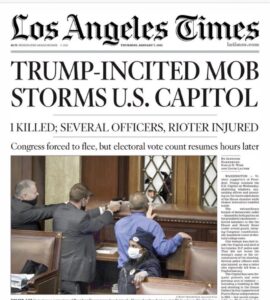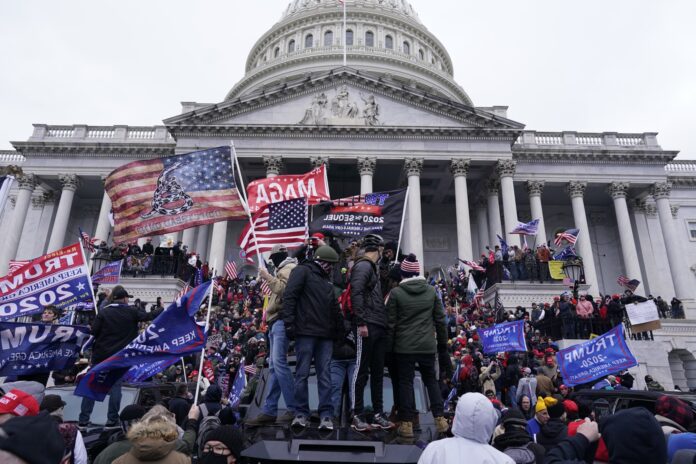On 6 January 2020, thousands of Donald Trump supporters stormed the American Capitol building, demanding an overturning of the recent American Presidential election results. They vandalized the capitol building and occupied the building for many hours. They also tried to disrupt the joint session of Congress, where Trump’s defeat would have been formally recognized.
Earlier that day, Trump addressed a crowd, where he encouraged his supporters to fight and take back the country. At the rally, many of Trump’s team used war-like imagery calling supporters to the capital. He insisted that his Vice-President, Michael Pence, had the power to stop the results from being declared.
Initially, it was not clear if Trump was going to lead the crowd or stand against them. He started posting on Twitter praises for the vandals. He called them great Patriots and asked them to go home in peace. He also criticized the election results, reinforcing the claims that the election was being stolen from him. Donald Trump’s Twitter account was then suspended, and he was only able to communicate by television.

Under pressure, Trump agreed to use the American National Guard (a reserve branch of the American army) to suppress the insurrection. This left 5 people dead, including one police officer.
Since the insurrection, many have feared that Trump may resist the transfer of power. His official term ends on 19 January.
The Trump phenomenon:
Trump has become a unique symbol of the growth of right-wing demagoguery. Even when devoid of substance, people in certain positions can rise and instil passions in large crowds of people. At times of crisis, their followers may follow them with a military-like zeal.
To everyone, except his followers, Trump appears as a ridiculous charlatan. It seems like a mystery as to why anyone would follow such a person at all, let alone with the passions that his followers have shown.
In 1848, Karl Marx was studying Europe. He noticed that France was veering into a crisis. In that crisis, there was a growing war, with workers in Paris calling for revolution. The ruling classes were in conflict, and could not move their Parliament forward. In this conflict, Napolean Bonaparte III, the nephew of the original Napolean Bonaparte, rose in politics. Like Trump, he was a con man, had loose morals, and came from an elite background. He came to power promising to restore France to greatness and to resolve the mess in the democratic system. Eventually, he staged a coup, leading to him being established as a monarch of France, and the loss of democracy and the free press in France for decades.
Marx observed that in times of such crisis, where the elites of a country cannot move forward, an individual can rise, promising to cut through the deadlock of the democratic process, refusing to engage in debate, and leading a return to some older time when things were not so complicated. This can also be accompanied by a suspicion of intellectuals, prioritizing action over thought, and criminalizing marginalized groups.
The individual who rises might not be particularly intelligent, and they might not work to end the crisis. In times of such uncertainty and conflict, even progressive forces might resign.

America’s Crisis:
In America, this conflict has been brewing for some time. From the 1970s, the American political establishment was mired in internal conflict. Neo-liberalism began to impress itself on government policy. Overt white-supremacy had been defeated by popular struggles of the 1960s. The political system could no longer rely on the conflict between agriculture and industry as it had before. As a result, there was a new bifurcation of American politics, a pro-tradition side, and a pro-change side. The political parties, Republican and Democratic-aligned accordingly. The old agrarian regions aligned with traditional values, and the industrialized sections aligned with change, though with some variation. Both of them were exceedingly pro-business, but in different ways, where fights against racism and poverty aligned with the Democratic party, and fights of traditional values, including religion, federalism, and original-intent readings of the constitutions aligned with the Republican party.
Also read: All Four members of SC appointed committee are Farm Laws Supporters
The intensity of antagonism between these sides grew. In 2008, with the stock market crash, the American establishment found itself in an intractable crisis. The search for the mystical personality who would save America began in earnest. They needed someone who could break the deadlock of the democratic process and change the course to a better way. This person had a simple message and would make America great. That person was Barack Obama. Obama was a charismatic personality who could navigate through the American waters, but still respectful of the American status quo. Though in power, he did not appear to have a personal agenda, and overtime blended into the existing establishment. He, therefore, did not address the crisis of American democracy, and at the end of his final Presidential term, the problems that brought him to power were left unaddressed.
Donald Trump rose when both sides of the American polity remained in crisis. The Democratic Party could no longer promise change. The Republican pro-tradition platform began to look empty. So much change, including changing racial compositions, applications of the constitution, and growing centralism that began with the War on terror, made both sides politically bankrupt.

Donald Trump came as a real change. He was not a career politician, but he knew them well. He did not engage in nuance and said what people wanted to hear. Using Twitter as a platform, he could engage in “straight-talk” and appeal to a base. At a time where the air was filled with noise, he became an audible voice. He stressed the pro-tradition message and cut through its contradictions by promising to make America great again.
Since then, many new forms of Right-wing have emerged. These right-wing groups fight against different types of changes they see in their society. This may include feminism and anti-racism. They are organized through the internet, creating networks of passionate followers, they evolved from internet trolls to organized militias. These groups have formed the base that led the siege of the American Capitol on 6 January.
With large media platforms, like Twitter and Facebook banning Trump, it seems that the American business elites have delivered a final blow against the Trump presidency, but the underlying issues that led to his rise remain. Trump may return, or another charismatic leader better at navigating the needs of the establishment may arise.




























[…] Trump’s aborted coup: How corrupt leaders can inspire […]